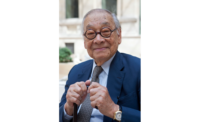Though born in China, I.M. Pei, who died on May 16 in New York City at age 102, became one of the most dominant American architects of his time.
Two of his major landmarks are the East Building of the National Gallery of Art in Washington, D.C., which opened in 1978, and the Grand Louvre glass pyramid in Paris, which opened in 1989.

Pei, who won the 1983 Pritzker Architecture Prize, also was the founder of a firm that combined high design and corporate success with international impact. He did that while establishing himself as one of the most sought-after individual designers of his generation.
“I.M. was a great man and one of the greatest architects of our lifetime,” says Leslie E. Robertson, co-owner of structural engineer See Robertson. “Beyond his incredible talents as an architect, he was quick to learn and understand new concepts and was very responsive to suggestions.”
Robertson worked on at least 15 of Pei’s projects. He says he was most inspired by the 72-story Bank of China in Hong Kong, which opened in 1989, and the Miho Museum southeast of Kyoto, Japan, which opened in 1997.
Pei grew up in Hong Kong. In 1935, he entered the University of Pennsylvania to study architecture, but soon transferred to the Massachusetts Institute of Technology for engineering. He then studied at Harvard’s Graduate School of Design.
He first worked for New York developer William Zeckendorf. In 1955, Pei formed his eponymous New York City firm. To free himself of administrative concerns, in 1991 he gave up his partnership in the renamed Pei Cobb Freed & Partners and became a consultant (ENR 12/13/93 p. 26). Soon, he began working with his two architect sons at Pei Partnership Architects, also in New York City.
Pei’s long-held view was that to build well and inexpensively, a quartet is needed, comprising the client, the architect, the engineers and the builders.
By Carter Wiseman with Nadine M. Post




